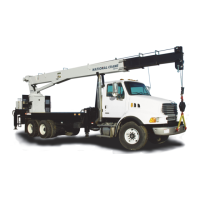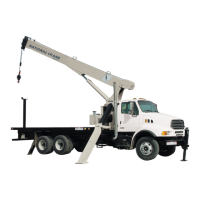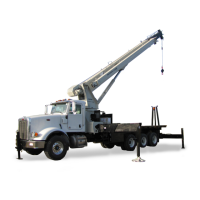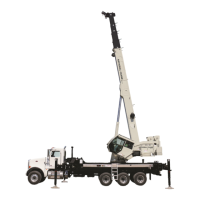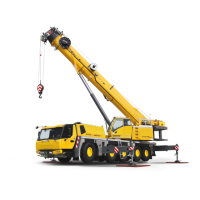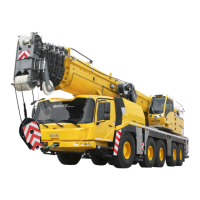2-9
4. Freely Suspended Load-Load hanging free with
no direct external force applied except by the
loadline.
5. Side Load-Horizontal side force applied to the
lifted load either on the ground or in the air.
6. Boom Length-Length of the boom, from boom
pivot pin to wire rope on last main boom section.
A decal on either side of the boom shows when
certain boom lengths are reached. The letters
on the intermediate boom lengths correspond to
the letters on the capacity chart.
7. Range Diagram-Corresponds to the pictorial in
the Capacity Chart. It shows the operating ra-
dius and height of the unloaded boom tip at all
boom lengths and angles. It should be used as
a guide to position unloaded loadline and to de-
termine approximate height to which the load can
be lifted.
The following procedure is a typical method which
must be used to determine the crane’s ability to handle
a load. The crane is equipped with a standard winch:
1. Determine the weight of the load and load han-
dling equipment.
2. Determine the radius from center line of crane
rotation to position of load.
3. Determine the radius from centerline of crane
rotation to center of point where load is being
moved to.
4. Refer to Capacity Chart for crane and determine
that load and radius of lifting are within capacity
of crane.
5. Refer to Capacity Chart for winch to determine
winch reeving is proper.
The following examples are for illustrative purposes
only. The examples utilize the capacity chart shown.
The load chart ratings, component weights and dimen-
sional data may not be the same as the actual unit. Al-
ways use actual information from the crane and job site
when planning a lift.
K6X
A load is to be lifted from the ground and weighs
5000 pounds (2267 kg) at a radius of 20' (6.09 m). It will
be placed on the roof of a building at a radius of 40'
(12.19 m) and a height of 65' (19.81 m) above the ground
on the opposite side of the truck.
$X8
Determine the load.
Load = 5000 lb (2267 kg)
1 Part Load Block = 150 lb (68 kg)
Sling = 30 lb (14 kg)
5180 lb (2349 kg)
$Z8
Starting Radius
Given = 20 ft (6.09 m)
$[8
Ending Radius
Given = 40 ft (12.19 m)
$\8
Refer to crane Capacity Chart.
Starting point: Assuming the boom is fully retracted
[27.5' (8.38 m) boom length], the capacity at a 20' (6.09
m) radius is 14,800 pounds (6,713 kg).
In order to get the load on the roof, the load must be
hoisted from the ground, swung around the rear of the
truck (deadspot in rotation is over the cab) and boom
extended to full 90' (27.43 m). At this point measure to
ensure load is at 40' (12.19 m) radius. Raise or lower
boom to achieve radius. Hoist load to a height that will
clear the top of the building and rotate to the point load
is to be placed. Lower the load using the winchline to
the roof.
Ending Point: The load rating at the ending point is
5850 pounds (2653 kg). The boom will be at 90' (27.43
m) extension and the loaded radius is 40' (12.19 m).
The crane has enough capacity at each end of the
lift to allow the lift to be made.
$]8
Lastly refer to winch Capacity Chart.
• Crane is reeved for single part line.
• Allowable load for single part line is 7700 pounds
(3492 kg) well above the 5180 pounds (2349 kg)
to be lifted.
Operator should now proceed to lift the load as
smoothly as possible.
Reference Only
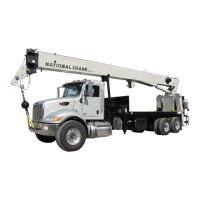
